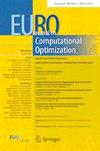Interior point methods in the year 2025
IF 1.7
Q2 OPERATIONS RESEARCH & MANAGEMENT SCIENCE
引用次数: 0
Abstract
Interior point methods (IPMs) have hugely influenced the field of optimization. Their fast development has been triggered by the seminal paper of Narendra Karmarkar published in 1984 which delivered a polynomial algorithm for linear programming and suggested that it might be implemented into a very efficient method in practice. Indeed, this has been demonstrated within a few years after 1984 and has gained IPMs a status of exceptionally powerful optimization tool. Linear Programming (LP) is at the centre of many operational research techniques including mixed-integer programming, network optimization and various decomposition techniques. Therefore, any progress in LP has far-reaching consequences. IPMs certainly did not disappoint in this context: they have become a heavily used methodology in modern optimization and operational research. Their accuracy, efficiency and reliability have been particularly appreciated when IPMs are applied to truly large scale problems which challenge any alternative approaches.
In this survey we will discuss several issues related to interior point methods. We will recall techniques which provide the building blocks of IPMs, and observe that actually at least some of them have been developed before 1984. We will briefly comment on the worst-case complexity results for different variants of IPMs and then focus on key aspects of their implementation. We will also address some of the most spectacular features of IPMs and discuss their potential advantages when applied in decomposition algorithms, cutting planes scheme and column generation technique.
2025年的内部点法
内点法对优化领域产生了巨大的影响。1984年,纳伦德拉·卡马卡发表了一篇开创性的论文,提出了线性规划的多项式算法,并表明它可能在实践中被实现成一种非常有效的方法,从而引发了线性规划的快速发展。事实上,这在1984年之后的几年内得到了证明,并使ipm获得了异常强大的优化工具的地位。线性规划(LP)是许多运筹学技术的核心,包括混合整数规划、网络优化和各种分解技术。因此,LP的任何进展都具有深远的影响。在这种情况下,ipm当然没有让人失望:它们已经成为现代优化和运筹学中大量使用的方法。当ipm应用于挑战任何替代方法的真正大规模问题时,它们的准确性、效率和可靠性尤其受到赞赏。在本次调查中,我们将讨论与内点法有关的几个问题。我们将回顾提供ipm构建模块的技术,并观察到实际上至少有一些技术是在1984年之前开发的。我们将简要介绍ipm不同变体的最坏情况复杂性结果,然后关注其实现的关键方面。我们还将讨论ipm的一些最引人注目的特征,并讨论它们在分解算法、切割平面方案和列生成技术中应用时的潜在优势。
本文章由计算机程序翻译,如有差异,请以英文原文为准。
求助全文
约1分钟内获得全文
求助全文
来源期刊

EURO Journal on Computational Optimization
OPERATIONS RESEARCH & MANAGEMENT SCIENCE-
CiteScore
3.50
自引率
0.00%
发文量
28
审稿时长
60 days
期刊介绍:
The aim of this journal is to contribute to the many areas in which Operations Research and Computer Science are tightly connected with each other. More precisely, the common element in all contributions to this journal is the use of computers for the solution of optimization problems. Both methodological contributions and innovative applications are considered, but validation through convincing computational experiments is desirable. The journal publishes three types of articles (i) research articles, (ii) tutorials, and (iii) surveys. A research article presents original methodological contributions. A tutorial provides an introduction to an advanced topic designed to ease the use of the relevant methodology. A survey provides a wide overview of a given subject by summarizing and organizing research results.
 求助内容:
求助内容: 应助结果提醒方式:
应助结果提醒方式:


